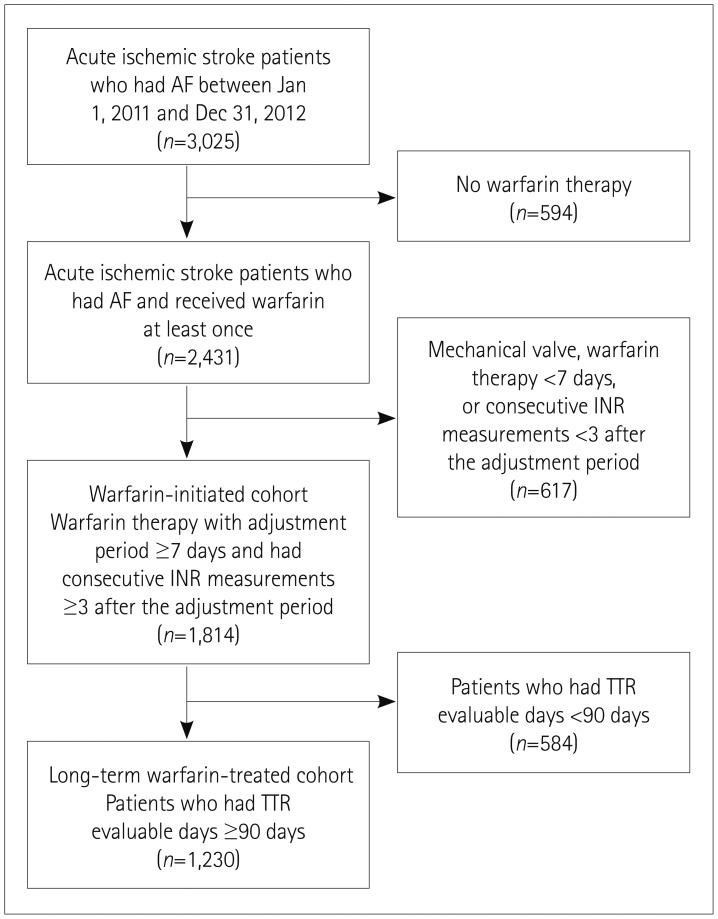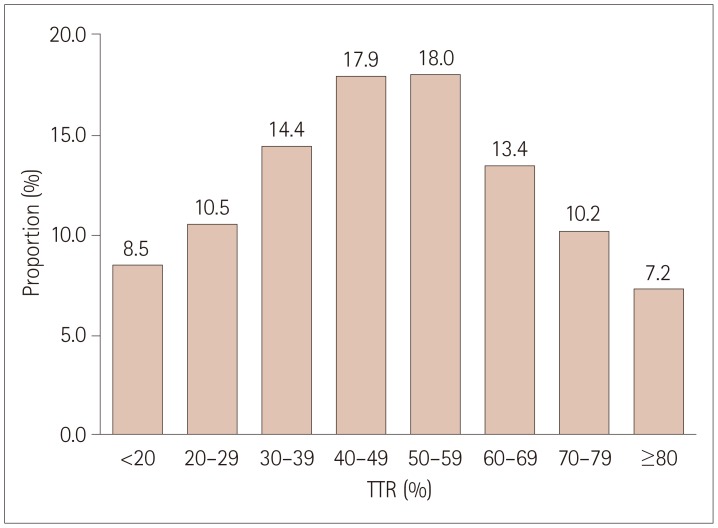J Clin Neurol.
2017 Jul;13(3):273-280. 10.3988/jcn.2017.13.3.273.
Quality of Anticoagulation with Warfarin in Korean Patients with Atrial Fibrillation and Prior Stroke: A Multicenter Retrospective Observational Study
- Affiliations
-
- 1Department of Neurology, Ilsan Paik Hospital, Inje University, Goyang, Korea. nrhks@paik.ac.kr
- 2Department of Medicine, Soonchunhyang University Hospital, Seoul, Korea.
- 3Department of Neurology, Seoul National University Bundang Hospital, Seoul National University College of Medicine, Seongnam, Korea.
- 4Department of Neurology, Yonsei University College of Medicine, Seoul, Korea.
- 5Department of Neurology, Asan Medical Center, University of Ulsan College of Medicine, Seoul, Korea.
- 6Department of Neurology, Samsung Medical Center, Sungkyunkwan University School of Medicine, Seoul, Korea.
- 7Department of Neurology, Dong-A University Hospital, Busan, Korea.
- 8Department of Neurology, Seoul National University Hospital, Seoul National University College of Medicine, Seoul, Korea.
- 9Department of Neurology, Inha University Hospital, Incheon, Korea.
- 10Department of Neurology, Hallym University Sacred Heart Hospital, Anyang, Korea.
- 11Department of Neurology, Eulji General Hospital, Seoul, Korea.
- 12Department of Neurology, Chonnam National University Hospital, Gwangju, Korea.
- 13Department of Neurology, Yeungnam University Medical Center, Daegu, Korea.
- 14Department of Neurology, Jeju National University Hospital, Jeju, Korea.
- 15Department of Neurology, Dongguk University Ilsan Hospital, Goyang, Korea.
- 16Department of Neurology, Soonchunhyang University Hospital, Seoul, Korea.
- 17Department of Neurology, Seoul Medical Center, Seoul, Korea.
- 18Clinical Research Center, Asan Medical Center, Seoul, Korea.
- 19Department of Biostatistics, Korea University College of Medicine, Seoul, Korea.
- KMID: 2391671
- DOI: http://doi.org/10.3988/jcn.2017.13.3.273
Abstract
- BACKGROUND AND PURPOSE
The quality of anticoagulation is critical for ensuring the benefit of warfarin, but this has been less well studied in Korean ischemic stroke patients with atrial fibrillation (AF).
METHODS
This study retrospectively analyzed the data of patients who had an AF-related ischemic stroke and were treated with long-term warfarin therapy in 16 Korean centers. The quality of warfarin therapy was primarily assessed by the time in therapeutic range [TTR; international normalized ratio (INR), 2.0-3.0] and additionally by the proportion of INR values within the therapeutic range.
RESULTS
The long-term warfarin-treated cohort comprised 1,230 patients. They were aged 70.1±9.7 years (mean±SD), 42.5% were female, and their CHAâ‚‚DSâ‚‚-VASc score was 4.75±1.41. The TTR analysis included 33,941 INR measurements for 27,487 months: per patients, 27.6 (SD, 22.4) INR measurements for 22.4 (SD, 12.9) months. The mean TTR of individual patients was 49.1% (95% confidence interval, 47.9-50.3%), and the TTR quartiles were <34.5, 34.5-49.1, 49.1-64.5%, and >64.5%. None of the 16 centers achieved a mean TTR of >60%. Of all INR measurements, 44.6% were within the therapeutic range, 41.7% were <2.0, and 13.7% were >3.0.
CONCLUSIONS
In Korean ischemic stroke patients who had AF, the quality of warfarin therapy was low and might be inadequate to effectively prevent recurrent stroke or systemic embolism.
Keyword
MeSH Terms
Figure
Cited by 1 articles
-
Stroke Prevention in Atrial Fibrillation: Focus on Asian Patients
Yan-Guang Li, So-Ryoung Lee, Eue-Keun Choi, Gregory Y.H. Lip
Korean Circ J. 2018;48(8):665-684. doi: 10.4070/kcj.2018.0190.
Reference
-
1. Jung KH, Lee SH, Kim BJ, Yu KH, Hong KS, Lee BC, et al. Secular trends in ischemic stroke characteristics in a rapidly developed country: results from the Korean Stroke Registry Study (secular trends in Korean stroke). Circ Cardiovasc Qual Outcomes. 2012; 5:327–334. PMID: 22474244.2. Kim BJ, Park JM, Kang K, Lee SJ, Ko Y, Kim JG, et al. Case characteristics, hyperacute treatment, and outcome information from the clinical research center for stroke-fifth division registry in South Korea. J Stroke. 2015; 17:38–53. PMID: 25692106.
Article3. Jones M, McEwan P, Morgan CL, Peters JR, Goodfellow J, Currie CJ. Evaluation of the pattern of treatment, level of anticoagulation control, and outcome of treatment with warfarin in patients with nonvalvar atrial fibrillation: a record linkage study in a large British population. Heart. 2005; 91:472–477. PMID: 15772203.
Article4. Gallagher AM, Setakis E, Plumb JM, Clemens A, van Staa TP. Risks of stroke and mortality associated with suboptimal anticoagulation in atrial fibrillation patients. Thromb Haemost. 2011; 106:968–977. PMID: 21901239.
Article5. Kim ES, Kim MS, Na WR, Sohn CM. Estimation of vitamin K intake in Koreans and determination of the primary vitamin K-containing food sources based on the fifth Korean National Health and Nutrition Examination Survey (2010-2011). Nutr Res Pract. 2013; 7:503–509. PMID: 24353837.
Article6. Bae JW, Kim HK, Kim JH, Yang SI, Kim MJ, Jang CG, et al. Allele and genotype frequencies of CYP2C9 in a Korean population. Br J Clin Pharmacol. 2005; 60:418–422. PMID: 16187974.
Article7. Gaikwad T, Ghosh K, Shetty S. VKORC1 and CYP2C9 genotype distribution in Asian countries. Thromb Res. 2014; 134:537–544. PMID: 24908449.
Article8. Wallentin L, Yusuf S, Ezekowitz MD, Alings M, Flather M, Franzosi MG, et al. Efficacy and safety of dabigatran compared with warfarin at different levels of international normalised ratio control for stroke prevention in atrial fibrillation: an analysis of the RE-LY trial. Lancet. 2010; 376:975–983. PMID: 20801496.
Article9. Singer DE, Hellkamp AS, Piccini JP, Mahaffey KW, Lokhnygina Y, Pan G, et al. Impact of global geographic region on time in therapeutic range on warfarin anticoagulant therapy: data from the ROCKET AF clinical trial. J Am Heart Assoc. 2013; 2:e000067. PMID: 23525418.
Article10. Wallentin L, Lopes RD, Hanna M, Thomas L, Hellkamp A, Nepal S, et al. Efficacy and safety of apixaban compared with warfarin at different levels of predicted international normalized ratio control for stroke prevention in atrial fibrillation. Circulation. 2013; 127:2166–2176. PMID: 23640971.11. Shimada YJ, Yamashita T, Koretsune Y, Kimura T, Abe K, Sasaki S, et al. Effects of regional differences in Asia on efficacy and safety of edoxaban compared with warfarin--insights from the ENGAGE AFTIMI 48 trial. Circ J. 2015; 79:2560–2567. PMID: 26460886.12. Park YK, Lee MJ, Kim JH, Kim SJ, Kim JS, Lee SY, et al. Lack of association of clinical factors (SAMe-TT2R2) with CYP2C9/VKORC1 genotype and anticoagulation control quality. J Stroke. 2015; 17:192–198. PMID: 26060806.13. Rosendaal FR, Cannegieter SC, van der Meer MJ, Briët E. A method to determine the optimal intensity of oral anticoagulant therapy. Thromb Haemost. 1993; 69:236–239. PMID: 8470047.
Article14. Dixon WJ, Massey FJ. Introduction to Statistical Analysis. 4th ed. New York: McGraw-Hill;1983. p. 105–107.15. Thane CW, Bolton-Smith C, Coward WA. Comparative dietary intake and sources of phylloquinone (vitamin K1) among British adults in 1986-7 and 2000-1. Br J Nutr. 2006; 96:1105–1115. PMID: 17181886.
Article16. Fulgoni VL 3rd, Keast DR, Bailey RL, Dwyer J. Foods, fortificants, and supplements: where do Americans get their nutrients? J Nutr. 2011; 141:1847–1854. PMID: 21865568.
Article17. Tsuboyama-Kasaoka N, Takizawa A, Tsubota-Utsugi M, Nakade M, Imai E, Kondo A, et al. Dietary intake of nutrients with adequate intake values in the dietary reference intakes for Japanese. J Nutr Sci Vitaminol (Tokyo). 2013; 59:584–595. PMID: 24477258.
Article18. Chiang CE, Wang KL, Lip GY. Stroke prevention in atrial fibrillation: an Asian perspective. Thromb Haemost. 2014; 111:789–797. PMID: 24500243.
Article19. JCS Joint Working Group. Guidelines for pharmacotherapy of atrial fibrillation (JCS 2008): digest version. Circ J. 2010; 74:2479–2500. PMID: 20962419.20. Yamaguchi T. Japanese Nonvalvular Atrial Fibrillation-Embolism Secondary Prevention Cooperative Study Group. Optimal intensity of warfarin therapy for secondary prevention of stroke in patients with nonvalvular atrial fibrillation: a multicenter, prospective, randomized trial. Stroke. 2000; 31:817–821. PMID: 10753981.21. Yasaka M, Minematsu K, Yamaguchi T. Optimal intensity of international normalized ratio in warfarin therapy for secondary prevention of stroke in patients with non-valvular atrial fibrillation. Intern Med. 2001; 40:1183–1188. PMID: 11813841.
Article22. Inoue H, Okumura K, Atarashi H, Yamashita T, Origasa H, Kumagai N, et al. Target international normalized ratio values for preventing thromboembolic and hemorrhagic events in Japanese patients with non-valvular atrial fibrillation: results of the J-RHYTHM registry. Circ J. 2013; 77:2264–2270. PMID: 23708863.23. Connolly SJ, Pogue J, Eikelboom J, Flaker G, Commerford P, Franzosi MG, et al. Benefit of oral anticoagulant over antiplatelet therapy in atrial fibrillation depends on the quality of international normalized ratio control achieved by centers and countries as measured by time in therapeutic range. Circulation. 2008; 118:2029–2037. PMID: 18955670.
Article24. Ansell J, Hirsh J, Hylek E, Jacobson A, Crowther M, Palareti G. Pharmacology and management of the vitamin K antagonists: American College of Chest Physicians Evidence-Based Clinical Practice Guidelines (8th edition). Chest. 2008; 133(6 Suppl):160S–198S. PMID: 18574265.25. Shin HW, Kim YN, Bae HJ, Lee HM, Cho HO, Cho YK, et al. Trends in oral anticoagulation therapy among Korean patients with atrial fibrillation: the KORean atrial fibrillation investigation. Korean Circ J. 2012; 42:113–117. PMID: 22396699.
Article26. Lip GY, Wang KL, Chiang CE. Non-vitamin K antagonist oral anticoagulants (NOACs) for stroke prevention in Asian patients with atrial fibrillation: time for a reappraisal. Int J Cardiol. 2015; 180:246–254. PMID: 25463377.
Article27. Kasmeridis C, Apostolakis S, Ehlers L, Rasmussen LH, Boriani G, Lip GY. Cost effectiveness of treatments for stroke prevention in atrial fibrillation: focus on the novel oral anticoagulants. Pharmacoeconomics. 2013; 31:971–980. PMID: 24085625.
Article28. Chang CH, Yang YH, Chen JH, Lin LJ. Cost-effectiveness of dabigatran etexilate for the prevention of stroke and systemic embolism in atrial fibrillation in Taiwan. Thromb Res. 2014; 133:782–789. PMID: 24642004.
Article29. Nelson WW, Choi JC, Vanderpoel J, Damaraju CV, Wildgoose P, Fields LE, et al. Impact of co-morbidities and patient characteristics on international normalized ratio control over time in patients with nonvalvular atrial fibrillation. Am J Cardiol. 2013; 112:509–512. PMID: 23800552.
Article30. Apostolakis S, Sullivan RM, Olshansky B, Lip GY. Factors affecting quality of anticoagulation control among patients with atrial fibrillation on warfarin: the SAMe-TT2R2 score. Chest. 2013; 144:1555–1563. PMID: 23669885.
- Full Text Links
- Actions
-
Cited
- CITED
-
- Close
- Share
- Similar articles
-
- Cardioembolic Stroke in Atrial Fibrillation-Rationale for Preventive Closure of the Left Atrial Appendage
- Anticoagulation in Atrial Fibrillation
- New oral anticoagulants
- How and When to Screen for Atrial Fibrillation after Stroke: Insights from Insertable Cardiac Monitoring Devices
- The Mechanism of and Preventive Therapy for Stroke in Patients with Atrial Fibrillation



